Warning: This story contains graphic photographs of poached elephants.
Just when it seems the elephant poaching crisis can’t get any worse, it does. Already besieged by habitat loss and isolation, Myanmar’s wild Asian elephants face a new threat — poachers who hunt them not just for their ivory, but for their skin.
A Sinking Stronghold for Wild Elephants
Myanmar’s forests shelter an estimated 1,400 to 2,000 wild Asian elephants, which form the world’s second-largest population after India. But today’s population is merely a fraction of its historic levels, which scientists estimate at around 10,000 elephants. And across Southeast Asia, elephant populations have collapsed by at least 50 percent in the last 30 years. Widespread habitat loss from deforestation and agricultural conversion pose the largest threat, which restricts the remaining population to isolated pockets and brings them into contact with people and poachers.
Poaching is not new — the insatiable demand for ivory has hammered both African and Asian elephant populations. Yet biology helped spare Asian elephants the brunt of the slaughter. Both male and female African elephants grow tusks, making either sex a prime target for poachers. But only 25 to 30 percent of male Asian elephants have tusks — depending on the regional population — which are smaller than those of African elephants. Females either remain tuskless or grow tiny vestigial stubs, called tushes, that barely extend beyond their lips.
But as African elephant populations disappear, Asian elephants are increasingly in the crosshairs to continue supplying China’s insatiable demand for ivory. And Myanmar is the perfect place for wildlife traffickers to poach and move their products.
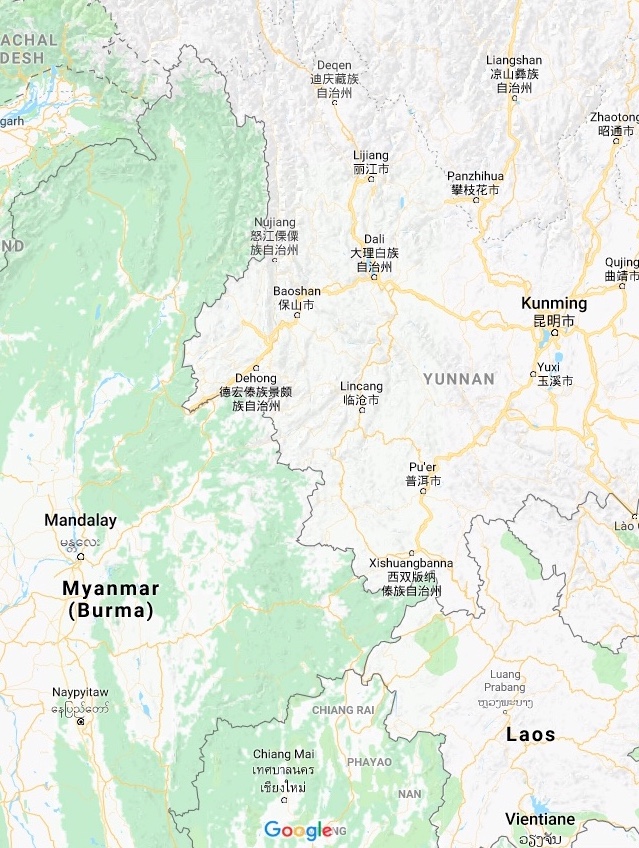
Myanmar’s role as a hotbed of illegal wildlife smuggling isn’t surprising. “It’s home to a lot of unique wildlife that are in high international demand, enforcement and legislation are still quite weak, and it’s next door to China, which has the greatest demand for many species,” says Chris Shepherd, executive director of Monitor, a nonprofit organization that works to reduce illegal and unsustainable wildlife trade.
Political unrest provides traffickers with an additional opportunity. The Chinese border runs along Kachin and Shan states, where minority ethnic groups have been at war with the central Burmese government for decades. With the ethnic armies controlling the area, the government has little to no ability to enforce laws or police border checkpoints, where smuggled timber and wildlife flows into China.
Along the border, once-small towns are transforming into Chinese enclaves where traffickers can sell their goods. In Mong La, the most significant entry point into southern Yunnan province, visitors could be forgiven for thinking they’re already across the border. Electricity and mobile phone service are run by Chinese providers, yuan is the dominant currency, and the street signs are in Mandarin. Shepherd describes Mong La as a wild-west town dominated by night clubs, brothels, casinos, exotic-meat restaurants, and vendors selling drugs and illegal wildlife products to an almost entirely Chinese clientele.
Mong La is so geared towards the wildlife trade that even the local zoo — now closed after selling its elephants to Thailand’s tourism trade — had a gift shop stocked with more than 200 pieces of ivory, leopard skins, and bear bile.
The traffickers moving illegal ivory through Myanmar benefit in part from a legal loophole permitting the sale of ivory from captive elephants. Myanmar has about 5,500 captive elephants used for work in the timber industry, and the Forest Department is allowed to sell ivory from those elephants upon their death. (Investigators with TRAFFIC report that the ivory is often spoken for before the elephant dies.) That loophole allowed traffickers to launder illegal ivory by claiming their goods are from captive elephants.
“Wildlife traders… generally they’re running circles around enforcement agencies, especially in countries where those agencies have limited capacity and where wildlife crime isn’t a high priority,” says Shepherd. “As long as a loophole like that exists, I can’t believe it isn’t being exploited to the max.”
As little as 15 years ago, tourists visiting Yangon and Mandalay could buy ivory chopsticks, name-seals and necklaces for as little as $10 or $20 USD. Shepherd says that these markets are disappearing, or moving underground, as the Burmese authorities improve their efforts to combat the illegal trade.
But as the situation improves in the major cities, elsewhere scientists are reporting a disturbing trend. Poaching rates are increasing, with elephants being killed not just for their ivory, but for their skin.
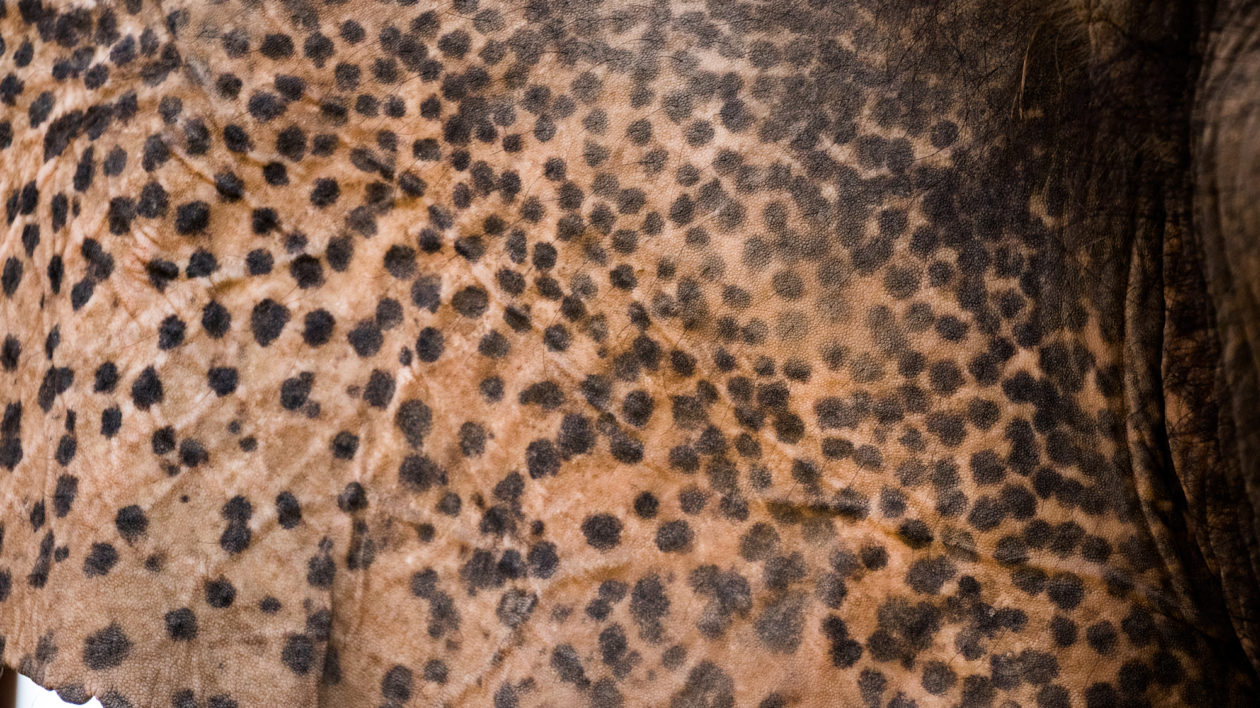
Stripped to the Bone
The first hints came in 2009, when Shepherd and other investigators from the TRAFFIC wildlife monitoring network returned to markets in Mong La to survey for illegal wildlife products. Three years earlier, they found only four pieces of elephant skin for sale. In 2009 that number jumped to 278 pieces, and by 2014 they counted more than 1,200 pieces of elephant skin.
Once sold in the markets, dried elephant skin is traditionally ground into a powder and then mixed with oil or elephant fat to create a paste purported to treat eczema, fungal infections, and other dermatological ailments. And the ever-creative wildlife traffickers have devised a new and incredibly revolting use for elephant skin: as jewelry. Dried skin is polished into small, translucent beads, which increase in value based on the amount of visible red blood vessels.
Shepherd’s surveys showed a similarly dramatic increase in carved ivory, with 0 in 2006, 200 pieces in 2009, and nearly 3,300 2014, plus 49 whole tusks. He says some of this increase is driven by an influx of African ivory, and other wildlife products, into Myanmar as its role as a trafficking hub grows. But African elephant skin is not known to be traded in Asia, suggesting that all of the skin sold in Mong La and elsewhere in Myanmar is sourced directly from Asian elephants.
Shepherd emphasizes that the skin trade is not new; he’s spent decades surveying markets for wildlife products and has always seen some skin for sale. “But in the past, the elephant skin for sale was probably a byproduct of the ivory poaching,” he says, “if you put all of that skin together it might not have amounted to very many elephants.”
Getting exact data on poaching levels for any species is difficult, but market surveys of wildlife products are a good indication of what’s happening in the forest, far from view. Shepherd says that the marked increase in locally sourced elephant skin in markets is a clear indication that poaching is on the rise in Myanmar. And new research on human-elephant conflict tells a similar story.
Human-elephant conflict is a serious problem in both Southeast Asia and Africa, where elephants can raid crops, destroy property, and kill people. Researchers from the Smithsonian Institution collared 19 elephants at four different locations in Myanmar, including the southern Bago Yoma mountains. By understanding how those elephants used the landscape, they hoped to identify ways to mitigate conflict with humans.
“We were collaring elephants and the first one was poached 3 months later,” says Christie Sampson, a field ecologist at the Smithsonian Institution. “Then another was killed 5 months later, and yet another 9 months later.” As more and more collars dropped off the map, Sampson and her colleagues searched for clues near the elephants’ last known locations.
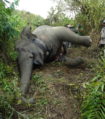
They found rotting carcasses strewn throughout the forest, sometimes as many as 20 dead elephants at a single site. Poachers stripped their skin away from the ribs and spine in sheaths, and piled hacked-off pieces trunk and skin on the forest floor. Many elephants were so mutilated that the researchers couldn’t even identify their age or sex.
The first time… I thought they had burned [the body] because it was all black,” says Sampson. “But then you realize they’ve skinned it and the blood attracts flies, so its this moving carpet of insects covering a beautiful elephant.”
Anecdotal reports from local villagers confirmed the obvious — poachers are active in the area and killings are increasing. Seven of the 19 collared elephants died within one year after collaring, and only one of those individuals had tusks. Subsequent investigations revealed that an additional 12 uncollared elephants had all disappeared during the course of the study, all within a 35 square-kilometer area in the southern Bago Yoma mountains.
To the southwest, Sampson’s collaborators discovered the carcasses of 20 elephants at a single kill site in the upper Ayeyarwady Delta. Over time more and more reports and bodies accumulated, resulting in a total of at least 40 poached elephants at their study sites in less than 3 years.
Sampson says little is known about how poachers operate or how they move their goods from the kill site to the markets. The existing anecdotal evidence paints a grim picture: Poachers typically use arrows or spears dipped in herbicides or other poison, which can take 2 to 3 days to kill an elephant. “And we can see in the collared elephants that it looks like they may be changing their movement patterns prior to when we find the poached carcasses,” says Sampson.
The carcasses they found were professionally butchered, suggesting that these poachers are part of a well-coordinated network, able to transport body parts quickly to the market. “There is some opportunistic hunting I’m sure, but I think generally across the board elephant poaching is organized,” says Shepherd. “You don’t shoot an elephant and only then start looking for a buyer.”
Aside from skin and ivory, the poachers will also cut off elephant feet for use as medicine and furniture, the tail and tail hair as a talisman for success and protection from supernatural attack, and the trunk and genitalia for human consumption.
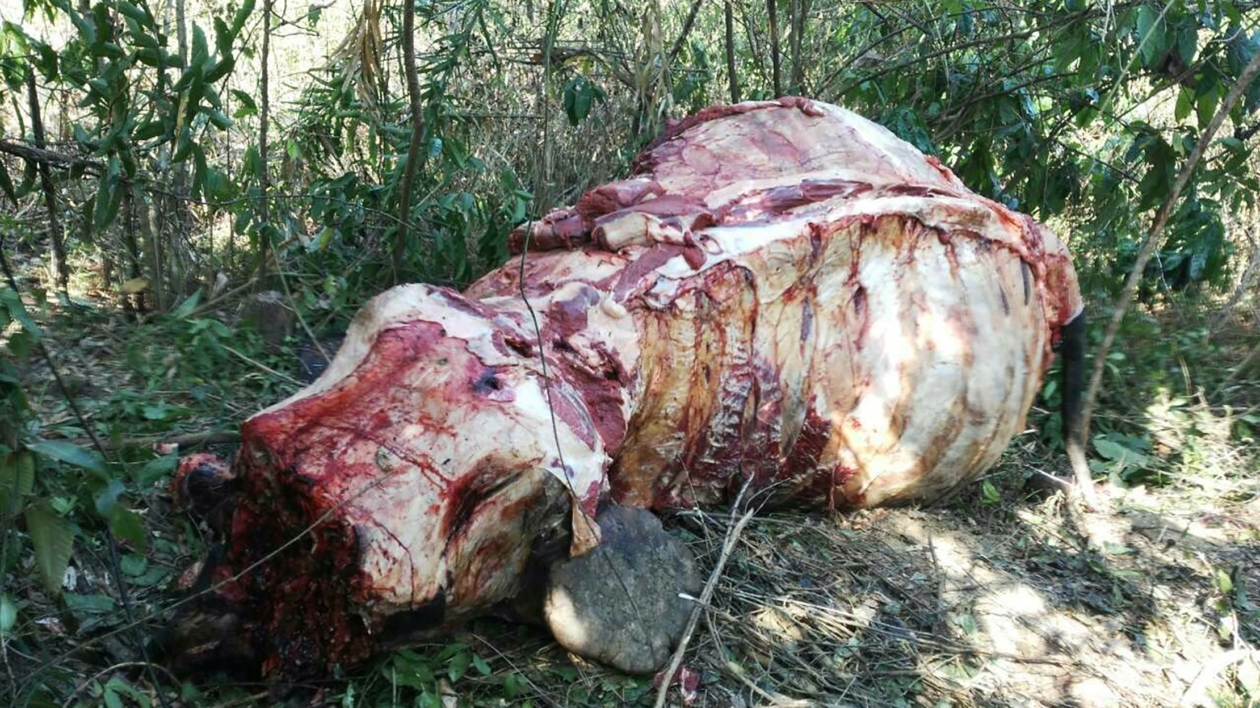
Our Last, Best Hope for Asian Elephants
The escalating skin trade poses a grave threat to wild elephants, perhaps even more so than ivory poaching, because every single elephant is at risk. “Females are much more important to elephant population stability,” says Sampson, “and if poachers go after skin they’ll kill the females as well as the males, so that will have a much bigger impact.”
With just 1,400 to 2,000 elephants left in Myanmar, the wild population is increasingly fragile. In another study, Smithsonian researchers estimated that the loss of 100 elephants each year could drive wild populations locally extinct by 2040. Though their study focused on the capture of live elephants for work in the timber trade, it illustrates just how fragile the wild population is to small, incremental losses, either by capture or poaching.
As Myanmar’s deforestation crisis continues, also fueled by a lucrative illegal trade, elephant habitat continues to shrink. Elephants restricted to small pockets of forest compete with each other for limited resources. Often, hunger draws them out of the deep forest to human settlements, where they damage property and raid crops.
Sampson says that habitat conversion to agriculture typically increases human-elephant conflict. At her Bago study site, the construction of two large reservoirs attracted both elephants eager for a permanent water source and an influx of people who were not used to living in close proximity to elephants. In two of the townships, she says that 2 to 4 people die each year as villagers try to defend their crops and homes.
Her current research focuses on quantifying other impacts of conflict, like how much time people lose guarding crops, or how often the danger of nearby elephants keeps children from attending school. Sampson is also curious to see if there is a correlation between human-elephant conflict and poaching.
At a national level, solutions to curb poaching and illegal wildlife trafficking depend, in part, on international cooperation. “The trade in Mong La isn’t going to change until the Chinese crack down on that border,” says Shepherd.
The trade in Mong La isn’t going to change until the Chinese crack down on that border.
Chris Shepherd
Paradoxically, Shepherd says that increasing enforcement elsewhere in China likely fueled Mong La’s rise as a trafficking hub. As it becomes more and more difficult to sell wildlife products in major Chinese cities, crime rings simply sell their goods on the Myanmar side of the border, where law enforcement is nonexistent. Then customers move the products into China.
The key, Shepherd says, is for Chinese authorities to ramp up border security so products can’t make it out of Myanmar. He points to Tachileik, another trafficking town on the Thai border, where a booming market for wildlife products almost entirely disappeared after Thai authorities tightened border security.
“The whole idea around CITES is that countries should work together,” says Shepherd. “You can’t just say it’s Myanmar’s problem, because the products aren’t being sold in Myanmar. So the onus is really on the authorities in China until whenever the political situation in Myanmar changes in that region.”
At the opposite end of the supply chain, wild elephants would also benefit from an increase in protected areas and anti-poaching efforts. Research shows that, compared to the rest of Southeast Asia, Myanmar has a large elephant population and the largest amount of elephant habitat left in the region. But when countries are ranked by how much elephant habitat is securely protected, Myanmar falls to the bottom of the list.
“Myanmar is probably one of the last, best hopes for Asian elephant conservation, because it has such a large amount of unfragmented habitat in comparison to the rest of the elephant’s range, and it has a supportive government and communities,” says Sampson. “If we are going to keep an Asian elephant population, this is one of the ones that we need to invest in protecting.”
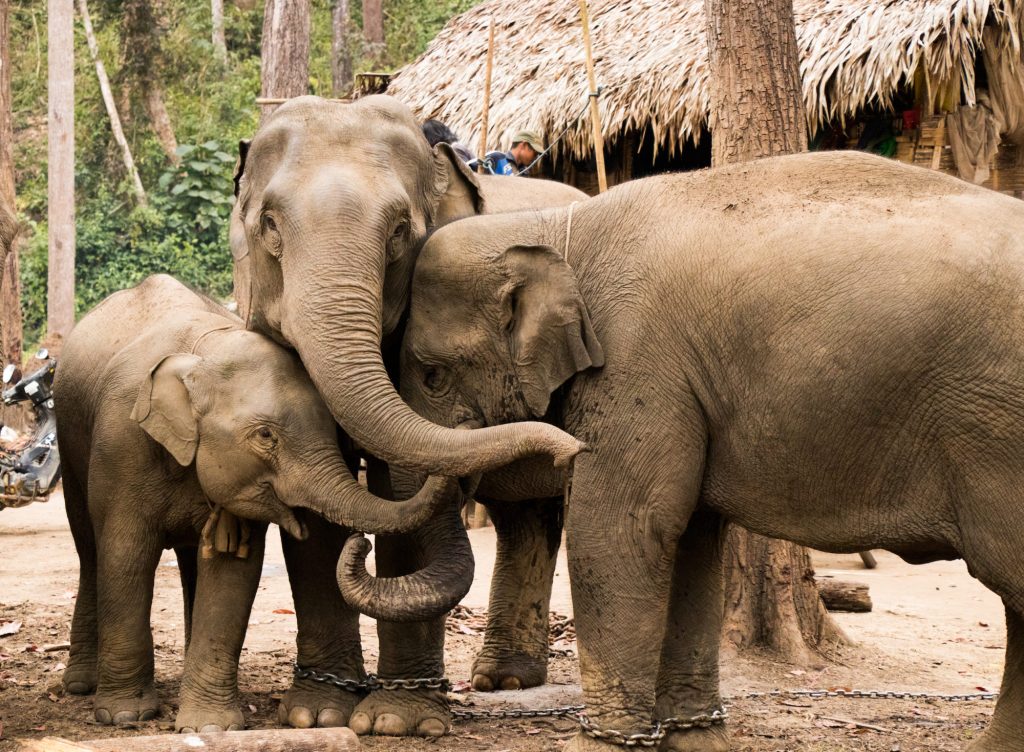



HOW ANIMALS NEED OUR HELP!!!!!! WOW!!!!!
OMG, how can we stop this? What is wrong with people? I am so sick of this cruelty to animals.
That is just horrific and disgusting. Why won’t they leave elephants alone? I would NEVER buy earring or anything else made of a wild animal skin or any other part of a wild animal. Cowhide is a bit different because they are bred, not endangered, and the beast is used for food as well. When will it be open season on poachers? I can hardly wait. They should be shot on sight and left for meat eating wild animals for feast on.
HORRIFYIN & APPALLING BEYOND WORDS!!!
How can we help??? What agencies/wildlife groups do you recommend (in addition to the N.C.)
It is so horrifying and frustrating that China is again complicit or outright guilty of another crime against Nature: ivory trade, elephant poaching, rhino poaching, rhino horn smuggling, illegal fishing in African waters, trade in hides of abused donkeys, dog abuse and dog meat trade, theft and slaughter of domestic cats for meat, …….. And on and on it goes. What an outage and a disgrace.
America and Trump have taught the rest of the world about ongoing greed- and Trump is still continuing this barbarism both by his own rules and the great “thrill” his idiot kids have doing their so called hunting and proudly showing their barbarism to the world.
Slaughtering these magnificent animals for any reason is horrific. I hope the methods of killing poachers, become more plentiful and lethal. Any anything else that will stop the slaughter.
Stop this B.S, right now. No animals has to die for trinkets!
That’s exactly what it is, trinkets. People don’t need to kill animals for trinkets. I mean, how would people feel if i cut off someones face and used it as a mask like hannibal lecter. If i call it a trinket does that make it ok.
Save all the Elephants now and forever.
China and the rest of Asia are all complicit in illegal animal slaughter for so called medical issues …If it isn’t tusks, now it is the skin…These gangster governments are part and parcel of wholesale poaching…Why not have a poacher killing army financed by groups that care about the survival of these creatures?…There are plenty of multimillionaires that care about the survival of these animals..Where are they when they are needed?.
What can I say, but that I despise such subhuman filth that murder such magnificent animals! I hope that people who love elephants take it upon themselves to wreak havoc upon these subhuman’s hides! None of them deserve to live another day.
As a “dominant” species, humans have NO bragging rights! Far too many wildlife species fall prey to the supposed “needs” of humans! Another species – not considered wildlife, I guess – are donkeys and burros all over the world. Again for their skins! Big business in Asian countries. And to be honest, it would seem to me that NONE of these “products” being taken(along with their lives) are necessary in any way ! Really good article – as always. The more people made aware – who have their eyes opened to what is being done to the natural world – the better.
What can be done – who do we contact? What group is working on this?
Hi Ellen, Thank you for your interest! The Nature Conservancy, the Smithsonian Conservation Biology Institute, TRAFFIC, and Monitor are all involved in working to protect elephants in Myanmar and beyond.
Stop killing elephants